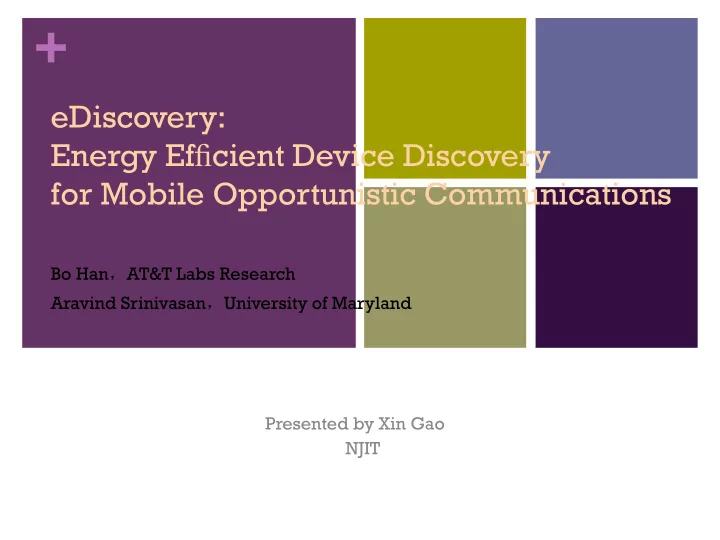

+ eDiscovery: Energy Ef fi cient Device Discovery for Mobile Opportunistic Communications Bo Han , AT&T Labs Research Aravind Srinivasan , University of Maryland Presented by Xin Gao NJIT
+ Summary 2 Background Introduction Motivation Method to Compute Energy Consumption eDiscovery Design Limitation and Extension
+ Background 3 Typical scenarios of opportunistic communications--- A message may be exchanged on buses and subways, between joggers and bikers, and in a shopping center and a food court, before finally reaching its destination.
+ Introduction 4 eDiscovery: an energy ef fi cient device discovery protocol eDiscovery adaptively changes the duration of Bluetooth inquiry and the probing interval in dynamic environments , by leveraging history information of discovered peers. It is implemented on Nokia N900 smartphones in three different environments It chooses Bluetooth over WiFi as the underlying wireless technology of device discovery eDiscovery performs better than STAR and RAL protocol : discovering more peers and consuming less energy
+ Motivation 5 This paper aim to design a device discovery protocol without changing the underlying communication protocol and thus make its deployment easy. Most papers about Bluetooth device discovery focus on the improvements of discovery latency between two Bluetooth devices by tuning various parameters or changing the protocol itself may not be feasible to implement on smartphones
+ Method to Compute estimated 6 Energy Consumption E = T idle · P idle + T probe · P probe T idle --the inquiry/scan interval P idle --the power for the idle state T probe --the duration of Bluetooth inquiry/WiFi scan P probe --the inquiry/scan state of Bluetooth/WiFi devices communication range: WiFi >Bluetooth discover peers: WiFi >Bluetooth However, energy efficient: WiFi <Bluetooth The average power of Bluetooth and WiFi device discovery in mW .
+ eDiscovery Design 7 Major design principle reduce smartphone energy consumption of device discovery, while not missing too many peers dynamically change the duration and interval of Bluetooth device discovery, based on the number of discovered peers Focus on the control of the inquiry window in this paper, as it is hard to predict the number of neighboring peers in practice
+ eDiscovery Design (contd.) 8 This function stops inquiry after 1.28× inquiry window seconds or it has received num responses inquiry responses. The two key parameters are inquiry window and inquiry interval , which control the duration and interval of Bluetooth inquiry. Reduce the inquiry duration and increase the inquiry interval when the number of neighboring peers is small By changing the constants N and I, it can achieve different trade-off between the number of discovered peers and smartphone energy consumption.
+ 9
+ eDiscovery Design (contd.) 10 We chose 5 + r to make the smallest inquiry window 4, because this is the minimum inquiry window to perform a complete scan of all possible frequency bands. This random variable r is refreshed for every inquiry.
+ Limitation & Possible extensions 11 It has evaluated only a few scenarios: one smartphone. Nokia N900 Need to port eDiscovery to other smartphone platforms, such as Android and iPhones Device discovery is only the first step of opportunistic communications. The next two steps are: service discovery data transfer
+ 12 END Thank you !
Recommend
More recommend